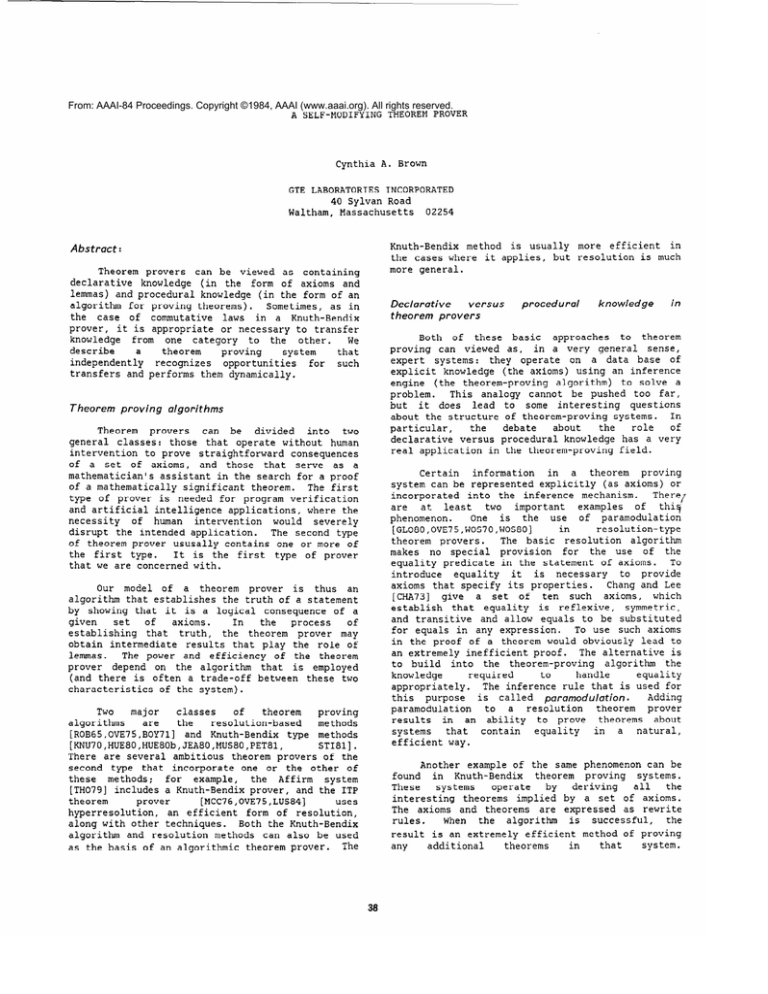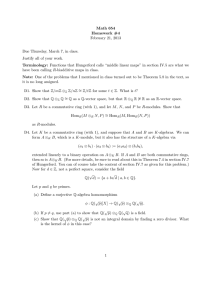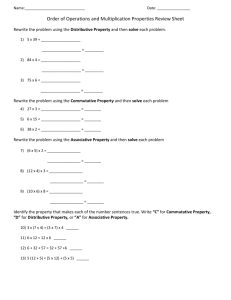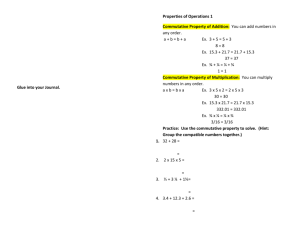
From: AAAI-84 Proceedings. Copyright ©1984, AAAI (www.aaai.org). All rights reserved.
A SELF-MODIFYING THEOREM PROVER
Cynthia A. Brown
GTE LABORATORIES INCORPORATED
40 Sylvan Road
Waltham, Massachusetts 02254
Abstract:
Theorem provers can be viewed as containing
declarative knowledge (in the form of axioms and
lemmas) and procedural knowledge (in the form of an
algorithm for proving theorems). Sometimes, as in
the case of commutative laws in a Knuth-Bendix
prover, it is appropriate or necessary to transfer
knowledge from one category to the other. We
describe
a
theorem
proving
system
that
independently recognizes opportunities for such
transfers and performs them dynamically.
Theorem
proving
algorithms
Theorem provers can be divided into two
general classes: those that operate without human
intervention to prove straightforward consequences
of a set of axioms, and those that serve as a
mathematician's assistant in the search for a proof
of a mathematically significant theorem. The first
type of prover is needed for program verification
and artificial intelligence applications, where the
necessity of human intervention would severely
disrupt the intended application. The second type
of theorem prover ususally contains one or more of
the first type. It is the first type of prover
that we are concerned with.
Our model of a theorem prover is thus an
algorithm that establishes the truth of a statement
by showing that it is a logical consequence of a
given
set of
axioms.
In
the process
of
establishing that truth, the theorem prover may
obtain intermediate results that play the role of
lemmas.
The power and efficiency of the theorem
prover depend on the algorithm that is employed
(and there is often a trade-off between these two
characteristics of the system).
Two
major
classes
of
theorem
proving
algorithms
are
the
resolution-based methods
[ROB65,OVE75,BOY71] and Knuth-Bendix type methods
[KNU70,HUE80,HUE80b,JEA8O,MUS8O,PET81,
STI81].
There are several ambitious theorem provers of the
second type that incorporate one or the other of
these methods; for example, the Affirm system
[TH079] includes a Knuth-Bendix prover, and the ITP
theorem
prover
[MCC76,OVE75,LUS84]
uses
hyperresolution, an efficient form of resolution,
along with other techniques. Both the Knuth-Bendix
algorithm and resolution methods can also be used
as the basis of an algorithmic theorem prover. The
Knuth-Bendix method is usually more efficient in
the cases where it applies, but resolution is much
more
general.
Declarative
versus
theorem
provers
procedural
knowledge
in
Both of these basic approaches to theorem
proving can viewed as, in a very general sense,
expert systems: they operate on a data base of
explicit knowledge (the axioms)
using an inference
engine (the theorem-proving algorithm) to solve a
problem. This analogy cannot be pushed too far,
but it does lead to some interesting questions
about the structure of theorem-proving systems. In
particular,
the
debate about
the
role
of
declarative versus procedural knowledge has a very
real application in the theorem-proving field.
Certain information in a theorem proving
can be represented explicitly (as axioms) or
incorporated into the inference mechanism. There?
are at least two important examples of thiq
phenomenon.
One is the use of paramodulation
[GL080,OVE75,WOS70,WOS80]
in
resolution-type
theorem provers. The basic resolution algorithm
makes no special provision for the use of the
equality predicate in the statement of axioms. To
introduce equality it is necessary to provide
axioms
that specify its properties. Chang and Lee
[CHA73] give a set of ten such axioms, which
establish that equality is reflexive, symmetric,
and transitive and allow equals to be substituted
for equals in any expression. To use such axioms
in the proof of a theorem would obviously lead to
an extremely inefficient proof. The alternative is
to build into the theorem-proving algorithm the
knowledge
required
to
handle
equality
appropriately. The inference rule that is used for
this purpose is called paramodulation.
Adding
paramodulation to a resolution theorem prover
results in an ability to prove theorems about
systems that contain equality in a natural,
efficient way.
system
Another example of the same phenomenon can be
found in Knuth-Bendix theorem proving systems.
These
systems operate by
deriving all the
interesting theorems implied by a set of axioms.
The axioms
and theorems are expressed as rewrite
rules.
When the algorithm is successful, the
result is an extremely efficient method of proving
additional
theorems
in
that
system.
any
Unfortunately, the algorithm can fail.
The
rewriting process on which it depends requires a
partial order on terms of the system such that each
rewrite results in a term that is smaller under the
partial order than the one from which it was
derived. It is therefore, for example, impossible
to include axioms that express the commutativity of
an operator, since there is no way to orient a
commutative law consistent with a partial order.
The solution is to deal with the commutative
property of operators on the level of the rewriting
algorithm, rather than treating it explicitly as a
rewriting rule.
The fact that an operator is
commutative can be recorded; then, whenever the
algorithm checks whether an expression involving
that operator can be applied, it tries both ways of
ordering the operands.
These axioms can be completed by the Knuth-Bendix
procedure to obtain a set of ten rewrite rules
sufficient to decide whether any two expressions
written in this system are equivalent. If we start
with an additional axiom,
4. x+x = 0,
the system will derive the fact that + is a
commutative operation. At that point it would be
necessary to restart the process, this time with
the initial stipulation that + is commutative.
The necessity of restarting the system is
annoying and is contrary to the goal of avoiding
the necessity of human intervention in the theorem
proving process. (This goal is extremely important
for practical program verification and artificial
intelligence systems.) Fortunately, a commutative
rule is easy to recognize. It is straightforward
to have the prover examine any unorderable rewrite
rule it has obtained (either as an initial axiom or
during the proving process) to see if it is a
commutative law.
If a commutative law is
discovered, that fact can be recorded and all
future applications of that operator can be done
using the commutative unification principle. If
the operator is also associative, the more powerful
associative-commutative unification can be used.
It is also helpful to check the already derived
rewrite rules to see if any can be simplified using
the fact that the operator is commutative.
For operators that are both commutative and
associative, a more elaborate scheme is required.
In this case a
commutative and associative
unification algorithm, which checks all possible
ways of matching two expressions that involve
nested
applications
of
a
commutative
and
associative operator, is used. Such algorithms are
surprisingly complex: the problem is equivalent to
finding certain partitions of integers [ST1811
Nevertheless, its use allows the application of
Knuth-Bendix methods to a much broader range of
systems than would otherwise be possible.
To
handle commutativity with a
special
unification algorithm is a necessity in KnuthBendix systems;
to deal with
equality via
paramodulation or a similar approach is a practical
necessity in resolution systems. There are also
cases of operators or properties that can be
handled either declaratively or procedurally. An
example is
the
idempotent property
of
an
associative and commutative operator; there is an
associative-commutative-idempotent
unification
algorithm, and idempotency can also be dealt with
by explicit rewriting. Some investigators are
attempting
to
develop
special
unification
algorithms to deal with other common properties of
operators in the framework of Knuth-Bendix systems
[JOU83,JOU82,HUL80].
One important unanswered question is the
extent to which previous work must be redone when
an operator is discovered to be commutative. All
previously discovered rules must still be valid,
but it is possible that some further rules may be
discovered by reconsidering the earlier results.
Until this can be resolved theoretically, the
systernplays it safe by regenerating all relevant
potential rules using the fact that the operator is
commutative, and checks that they reduce to a
common form.
Implementation
Dynamic
laws
recognition
of commutative
and
associative
A Knuth-Bendix theorem prover embodying these
ideas has been implemented in Prolog. At present
it is able to recognize a commutative law and use
the commutative unification algorithm on operators
for which such laws have been discovered. It also
recognizes explicit associative laws, and will use
commutative-associative unification for operators
that have both properties. If an operator that is
known to be associative is found to also be
commutative, the associative law is removed from
the list of explicit rewrite rules belonging to the
system. (No practical unification algorithm for
the associative property alone is known.)
A Knuth-Bendix theorem prover starts with a
set of axioms and derives rewrite rules from them.
If the prover is able to deal with commutative
operators, then it will notice whether the main
operator in an expression is commutative or not and
the appropriate unification algorithm.
apply
Ordinarily the prover is told which operators are
commutative at the start of its run. However, it
is possible for the stated properties of an
operator to imply that it is commutative without
the commutative axiom being given explicitly. For
example, here are the group axioms, written in
additive notation:
As an example, consider the group theory
The system completes the
axioms given above.
original three axioms by deriving rewrite rules in
the following order:
1. 0+x = x
2. -x+x = 0
3. (x+y)+z = x+(y+z).
39
properties are discovered, the ability to recognize
those properties can be built into the system,
provided
they
can
easily
recognized
be
syntactically. Unfortunately, it is necessary to
devise a new unification algorithm for each desired
combination
of properties, and this is no easy
matter.
Associativity
and
commutativity are
probably the most generally useful properties, and
a system that simply recognizes those (and thereby
provides a good method for handling commutativity)
should be most useful. A review of the currently
available
unification
algorithms
and
their
properties is given in [SIE84].
-x+(x+y)
= y
-0+x = x
--x+0
= x
4.
5.
6.
7.
8.
--0+x = x
-0 = 0
--x+y
= x+y
9.
10.
11.
12.
13.
14.
15.
16.
17.
18.
19.
20.
21.
x+0 = x
x+(-x) = 0
--x = x
x+(-x+y) = y
x+(y-(x+y)) = 0
-(x+y>+(x+(y+z)) = z
x+(y+(-(x+y)+z)) = z
x+(y+(z-(x+(y+z)))) = 0
x-(y+x) = -y
x+(y-(z+(x+y))) = -z
Also, while the commutative property is easy
to recognize syntactically, there may be axioms
present that imply the associative property and
that lead to unorderable rules when the commutative
law is applied to them. It would be helpful if the
system could attempt to prove the associative law
whenever it got into trouble with an unorderable
rule for an operator known to be commutative and
not known to be associative. In this way the order
of discovery of properties would not be such a
crucial factor in the success of the algorithm.
(In general, it is a good strategy to postpone
processing of unorderable rules in the hope that
future rewrite rules can be used to eliminate
them.)
x+(-(y+x)+z)
= -y+z
-(x+y)
= -y+(-x)
20
are
5,6,7,9,14,15,16,17,18,19, and
Rules
eliminated during the process by being simplified
using later rules; the final set has the remaining
ten elements.
It is interesting to contrast this derivation
with the one obtained by starting with the three
group theory axioms plus the fourth axiom given
above, stating that the group operation is
idempotent. The following rules are discovered in
order:
5.
6.
7.
8.
9.
10.
11.
12.
13.
14.
15.
16.
17.
18.
19.
Another area for research is the efficiency of
the
associative
and
commutative unification
algorithm. The usual algorithm often generates many
redundant possibilities; it should be possible to
develop methods to recognize and avoid them.
Finally, the Knuth-Bendix algorithm itself should
be
studied to identify potential speed-ups.
Progress in this direction has already been made by
Huet [HUE81].
-x+(x+y)
= y
x+(y+(x+y))
= 0
x+(x+y)
= y
-0+x = x
-0 = 0
--x+0 = x
-x+0 = x
-x = x
x+0 = x
x+(y+(x+(y+z)))
= 2
x+(y+(z+(x+(y+z))))
= 0
x+(y+x)
= y
x+(y+(z+(x+y)))
= 2
x+(y+(x+z))
= y+z
References
x+y = y+x
[BOY711 BOYER, R. S., "Locking: a restriction of
resolution", Ph.D. Thesis, University of
Texas at Austin, 1971.
At this point, the system recognizes that + is
commutative and associative. Rule 3 is removed from
the rule database, and the shift to associativecommutative unification for applications of the +
operator is made. The discovery of rule 19, like
the discovery of rule 21 in the previous example,
causes many of the earlier rules to disappear. For
example, it is no longer necessary to have rules
showing that 0 is both a left and a right identity.
[BOY791 Boyer,
R.
Computational
S.,
and
Logic,
J. S. Moore, A
Academic Press, New
York, 1979.
[CHA73] Chang, C. L. and R. C. T. Lee, Symbo/ic
Logic
and
Mechanical
Theorem
Proving,
Academic Press, New York, 1973.
This example demonstrates the ability of the
theorem prover to modify itself in response to its
discoveries. The extra checking involved consumes
a negligible amount of time and greatly expands the
capacities of the prover to handle sets of axioms
without human intervention.
Future
"Associative-Commutative
[FAG841 Fages,
F.,
Unification", INRIA, Domaine de Volceau
Rocquencourt, 78153 Le Chesnay, France,
1984.
[GL080] Gloess, P. Y., and J. P. H. Laurent,
"Adding Dynamic Paramodulation to Rewrite
Algorithms",
in
5th
Conference
on
Automated
Deduction,
W. Bibel and
R.
Kowalski, eds., Springer Verlag LNCS 87,
Berlin 1980, pp.195-207.
work
Many further improvements are possible on this
system.
As unification algorithms for other
40
[ GOG78]
Goguen, J. A., J. W. Thatcher, and E. G.
Wagner, "An Initial Algebra Approach to
the
Specification,
Correctness,
and
Implementation of Abstract Data Types", in
Current
Methodology,
Trends
in
1982, pp. 396-405.
[KNU70] Knuth, D., and P. B. Bendix, "Simple Word
Problems
in Universal Algebras",
in
COMPUTATIONAL
PROBLEMS
IN
ABSTRACT
ALGEBRA, J. LEECH, PERGAMON PRESS 1970,
PP. 263-279.
Programming
v. 4, R. Yeh, ed., PrenticeHall (1978), pp. 80-149.
[ GOG80]
Goguen, J. A., "How to prove algebraic
inductive hypotheses without induction,
with applications to the correctness of
data
implementation",
in
5th
We
W.
Conference
on Automated
Deduction,
Bibel and R. Kowalski, eds., Springer
Verlag LNCS 87, Berlin 1980, pp.356-373.
[LUS84] Lusk, E.L., and Overbeek, R. A., "A
Portable Environment for Research
'
Automated Reasoningtl, in 7th Conferen::
on
[HER301 Herbrand, J., "Investigations in proof
theory: the properties of propositions",
in From Frege to Goedel:
A Source
Book
in Mathematical
Logic,
J. van Heijenoort,
ed., Harvard University Press, Cambridge,
Mass.
Seventh
Bibel
and
ACM
Symp.
on
POPL,
[PET811 Peterson, G. E., and M. E. Stickel,
"Complete sets of reductions for some
equational theories", JACM v. 28, no. 2,
1981, pp. 233-264.
[ROB651 Robinson, J. A., "A machine-oriented logic
based on the resolution principle", JACM
12(l), 1965, pp. 23-41.
[ROB65b] Robinson, J. A., "Automatic deduction with
hyper-resolution", Internat.
J.
Comput.
Math.,
1, pp. 227-234.
[SIEVE] Siekmann, J. H., "Universal Unification",
in
7th
Conference
on
Automated
Shostak, ed., Springer
Deduction,
R.
Verlag LNCS 170, Berlin 1984, pp.l-42.
and
?
Kowalski, eds., Springer Verlag LNCS 87,
Berlin 1980, pp.396-405.
[JEA80] Jeanrond,
H.
J.,
"Deciding
Unique
Termination of
Permutative Rewriting
Systems:
Choose
Your
Term
Algebra
Carefully",
in
Conference
5th
Automated
Deduction,
W. Bibel and "R':
Kowalski, eds., Springer Verlag LNCS 87,
Berlin 1980, pp.335-355.
[sTI~I] Stickel, M. E., "A unification algorithm
for associative-commutative functions",
JACM,
v. 28, no.3, 1981, pp.423-434.
[TH079] Thompson, D.
H.,
USC
ed.,
AFFIRM
Reference
Information
Sciences
[WOS70] wos,
L.,
G.
A.
and
"Paramodulation and Set of
Robinson,
Support",
Manual,
Institute, 1979.
Proc .
Automatic
SumpVersailles,
France,
1968,
[JOUST] Jouannaud, J. P., "Confluent and Coherent
Equational
Term
Rewriting
Systems:
Application to Proofs in Abstract Data
Types," Technical Report 83-R-005, Centre
de Recherche en Informatique de Nancy,
1983.
[JOUST] Jouannaud,
Kirchner,
Equational
Twentieth
Annual
[OVE75] Overbeek, R. A., "An implementation of
hyperresolution", Comput.
Math.
Appl.
1, 1975, pp.201-214.
[HUE811 Huet, G., "A Complete Proof of the
Correctness of the Knuth and Bendix
Completion Algorithm," JCSS 23, 1981, pp.
11-21.
W.
ed. I
1984,
1980, pp. 154-162.
[HUE80b] Huet, G., and D. Oppen, "Equations and
Rewrite Rules - A Survey", in Formal
Language
Theory,
R. Book, ed.,
Academic
Press, N.Y., 1980, pp.349 - 405.
Deduction,
R. Shostak,
170, Berlin
[MUSHY] Musser, D. L., "On proving inductive
properties of abstract data types", Proc.
[HUE801 Huet, G., and J. M. Hullot, "Proofs by
Induction in Equational Theories with
Constructors",
Twenty-first
Annual
Symposium on Foundations of Computer
Science, IEEE Computer Society, 1980, pp.
96-107.
Automated
Automated
[MCCOY] McCharen, J. D., R. A. Overbeek, and L.
was, "Problems and experiments for and
with automated theorem-proving programs",
IEEE Trans.
Cornput.,
V. 25, No. 8, 1976,
pp. 773-782.
[GUT781 Guttag, J., E. Horowitz, and D. Musser,
"Abstract
Data
Types
and
Software
Validation", CACM v. 21, no. 12, 1978,
pp.1048-1063.
[HUL80] Hullot, J. M., "Canonical Forms
Unification",
5th
Conference
Deduction,
Springer Verlag LNCS
pp.l-42.
Demonstration
Springer-Verlag,
,
New York (1970), pp.276-310.
[WOSSO] Wos, L., R. Overbeek, and L. Henschen,
"Hyperparamodulation: A
Refinement of
Paramodulation", in 5th
Conference
on
Automated
J. P., C. Kirchner, and H.
"Incremental Unification in
Theories", Proceedings of the
Annual
Allerton Conference,
Deduction,
W.
8ibel
and
R.
Kowalski, eds., Springer Verlag LNCS 87,
Berlin 1980, pp.208-219.
41






